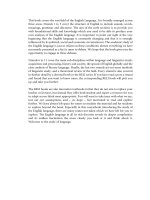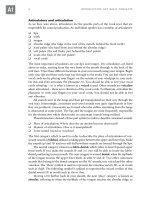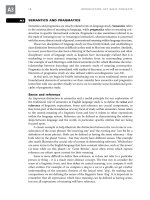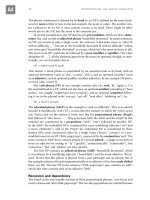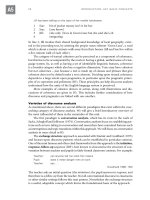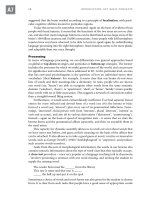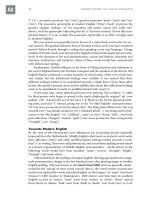Introdungcing English language part 15 pdf
Bạn đang xem bản rút gọn của tài liệu. Xem và tải ngay bản đầy đủ của tài liệu tại đây (317.27 KB, 6 trang )
70 DEVELOPMENT: ASPECTS OF ENGLISH
Each of these four maxims follows the ‘maximise’ and ‘minimise’ style of the polite-
ness principle itself. For tact, speakers should ‘minimise cost to other’ and ‘maximise
benefit to other’. With generosity, speakers should ‘minimise benefit to self ’ and
‘maximise cost to self ’. With approbation, speakers should ‘minimise dispraise
of other’ and ‘maximise praise of other’. With modesty, speakers should ‘minimise
praise of self ’ and ‘maximise dispraise of self ’.
Work your way through these four politeness maxims and write down scenarios
from your day-to-day interactions where you have abided by these principles. Did these
strategies always work in maintaining co-operativeness and harmony? Can you
think of scenarios where you did not abide by these politeness maxims? If so,
what happened?
By far the most influential theory of pragmatic principles for politeness is Brown
and Levinson’s (1987) set of politeness universals. Although Brown and Levinson’s
theory has been criticised, it does provide a systematic account of the crucial role that
politeness plays in the conversational strategies we use when interacting with one another.
Many pragmatics researchers still draw upon many of the specific principles from Brown
and Levinson’s work.
Brown and Levinson’s (1987) theory is based upon the concept of face: the public
self-image that all rational adults across all cultures possess. Face consists of two
components: negative face, the desire to be unimpeded, and positive face, the desire
to be liked, admired or needed. All participants in spoken interaction emotionally invest
in face, and it must be constantly considered. Influenced by Grice’s co-operative prin-
ciple, Brown and Levinson argue that it is in the mutual interests of interactants to
maintain each other’s face in conversation. Strategies known as positive politeness
and negative politeness are identified to attend to individuals’ positive and negative
face respectively (see below). They are designed to enable interactants to abide by the
co-operative principle.
If a demand or an intrusion needs to be made on another person’s autonomy,
then this is identified as a potential face-threatening act (FTA). When speakers are
posed with performing an FTA, they firstly have to decide whether it should be
performed on record or off record. The off-record strategy enables a speaker to avoid
responsibility for performing an FTA by inviting conversational implicature.
Speakers also have the option of not performing the FTA at all.
However, if the FTA is to be performed, then a speaker can do this in one of the
following ways:
q Bald on-record, without redressive action
Examples are ‘Give me that!’ or ‘Get out!’ According to Brown and Levinson,
speakers will only perform an FTA without politeness strategies if a situation is
urgent or in the interests of efficiency. For example, if the room is on fire, a speaker
would be wasting time addressing the hearer’s face needs – instead we would expect
the speaker to issue a bald, on-record direct command to stress the urgency of the
situation and ensure that the hearer responds accordingly.
q Using positive politeness: where the speaker pays attention to the hearer’s posi-
tive face needs by demonstrating that the hearer’s wants or needs are thought of
as desirable. Examples are as follows:
PRAGMATIC PRINCIPLES 71
m claim common ground
m use in-group identity markers such as nicknames
m express interest in hearer
m seek agreement, avoid disagreement
m exaggerate your interest, approval or sympathy with the hearer
q Using negative politeness: where the speaker desires not to impose on the hearer
by restricting the hearer’s actions, thus paying attention to the hearer’s negative
face needs. Examples are as follows:
m question/hedge
m indicate pessimism
m minimise the imposition
m give deference
m apologise
m impersonalise: ‘patrons are reminded not to walk on the grass’
Negative politeness strategies will often co-occur, as in the following example: ‘I’m
terribly sorry to bother you but I don’t suppose I could borrow your computer for
just a few minutes? I really wouldn’t be that long.’
Brown and Levinson’s concentration on strategies which avoid the performance
of FTAs and their reliance on the co-operative principle has led to criticisms that they
leave the area of impoliteness overlooked. Researchers have argued that it is impos-
sible to have a comprehensive theory of politeness if impoliteness, a crucial part of the
overall theory, is ignored. Culpeper (1996, 2005b) argues that, in order for a theory
of politeness to be comprehensive, it is integral for the topic of linguistic impolite-
ness to be properly addressed and for strategies of impoliteness to be defined.
Culpeper (1996, 2005b) revisits Brown and Levinson and devises an opposite
parallel strategy to account for impoliteness. Culpeper questions Brown and Levinson’s
belief that impoliteness is marginal to everyday conversations. He argues that it is far
more common in everyday conversation than initially thought (by theorists such as
Grice) and thus an analytical impoliteness framework needs to be developed.
Culpeper defines impoliteness as follows:
Impoliteness comes about when: 1) the speaker communicates face-attack intentionally
or 2) the hearer perceives and/or constructs behaviour as intentionally face-attacking,
or a combination of (1) and (2).
(Culpeper 2005b: 38)
He coins the following impoliteness versions of Brown and Levinson’s original strat-
egies given above:
q Bald on-record impoliteness
This strategy is deployed where there is an intention to attack face and this is
performed in a direct, clear, unambiguous way. Here and in the definition of
impoliteness, it is important to note that Culpeper draws upon the concept
of a face attack act (FAA), first coined by Austin (1990), as opposed to an FTA,
to distinguish clearly a deliberate intention to attack face.
In the following example taken from a documentary on parking attendants, the
sequence highlighted in italics exemplifies a bald, on-record FAA: ‘you’re a
SWIN|KCrEIB1Qqc8svpQueSEh0w==|1282035854
72 DEVELOPMENT: ASPECTS OF ENGLISH
parking attendant act like one okay shut up and act like a parking attendant’ (Culpeper
et al. 2003: 1556).
q Positive impoliteness – damage positive face wants:
m ignore/snub the other
m deny common ground with the other
m be disinterested, unconcerned, unsympathetic
m select a sensitive topic
m use inappropriate identity markers
m use obscure/secretive language
m seek disagreement
m use taboo words
m call the other names etc.
q Negative impoliteness – damage negative face wants:
m frighten
m condescend
m scorn
m ridicule
m invade the other’s space literally or metaphorically.
Additionally, Culpeper (1996, 2005b) inserts the following two categories:
q Sarcasm/mock impoliteness: a strategy performed with the use of politeness
strategies that are obviously insincere, and thus remain surface realisations
q Withholding politeness: the absence of politeness where it would be expected,
as in:
m keeping silent
m failing to act
(Culpeper 2005b: 41–2)
One of the main sources that Culpeper examines to demonstrate how his model of
impoliteness works is media data, and television programmes in particular. He has
focused on documentaries, quiz programmes and films, where there is frequently conflict
between interactants. Indeed, media data are productive sources to use for examina-
tions of impoliteness, as in recent years there has been an observable move by mul-
tiple broadcast networks to produce shows where impoliteness directly correlates with
entertainment.
Drawing upon Culpeper’s impoliteness strategies listed above, consider how the
following television programmes rely upon impolite interactions for their entertain-
ment values – the majority of these programme are broadcast globally. Consider
how strategies of impoliteness are realised in the shows listed. Add any other examples
that you can think of (if you are not familiar with any of these examples, clips can
be found online):
X-Factor
,
Pop Idol
,
America/Britain’s Got Talent
,
Wife Swap
,
Jerry Springer
,
The
Apprentice
,
Big Brother
,
The Weakest Link
;
several shows hosted by TV chef Gordon Ramsay:
The ‘F’ Word
,
Ramsay’s Kitchen Nightmares
,
Hell’s Kitchen
.
SYNTAX 73
Why have these television shows based upon impoliteness become so popular in Western
culture? Culpeper (2005b: 45) suggests the following reasons:
1 Intrinsic pleasure: the thrill of arguing for its own sake;
2 Voyeuristic pleasure;
3 The audience is superior: humour and pleasure can stem from the audiences
laughing at others who are in a worse state than themselves;
4 The audience is safe (unlike if you were physically present, witnessing a fight in
a pub or on a street).
In Gordon Ramsay’s television shows recorded and broadcast in the US, taboo words, and
certain expletives in particular, are bleeped out. However, when Ramsay’s Kitchen Night-
mares USA was broadcast back in the UK, the expletives were put back in by UK pro-
gramme producers and the bleeping was removed. This process neatly highlights a cultural
difference in the boundaries of ‘appropriate’ language. The strength of the positive impo-
liteness strategy of taboo language appears to be evaluated differently in different English-
speaking countries, reflected in the different practices adopted by programme producers.
Another criticism which has been levelled at Brown and Levinson is that, whilst their
model claims to be a set of universal principles, there are many differences in politeness
norms and conventions across different cultures which cannot be accounted for by
their approach. As we can see from the above example, this can happen within the same
language and when spoken by the same individual but in a different cultural setting.
As we can see when considering World Englishes (strand 10), the English language
is used in a significant number of countries by a range of speakers from a multitude of
cultural backgrounds. Politeness norms and conventions will vary from culture to culture
even when the same language is spoken. Investigating inter-cultural and cross-cultural
interactions from the perspective of politeness and pragmatics more generally can produce
some very interesting findings in terms of cultural differences between different groups.
Maxims answers
At the bus stop: Quality
The arguing couple: Quantity
Student talk: Quality
The couple and the laundry: Relevance
Friends over dinner: Quantity (too much information) and Manner (unnecessary
wordiness)
SYNTAX
Aside from labelling the parts of speech (see A4), the components of a sentence can
be viewed in terms of what they do. This more functional approach to grammar impinges,
to a certain extent, on semantics and pragmatics (see A3 and B3), since meaning-
fulness is being combined with syntactic form. Some grammars of English prefer
B4
74 DEVELOPMENT: ASPECTS OF ENGLISH
to remain entirely at a formalist level – the most influential of these are the genera-
tive grammars which are exclusively interested in syntactic rules. In that approach,
the rules by which allowable syntactic sequences are created or transformed into other
well-formed clauses are the focus of formal notation. A famous early example is the
rule of ‘whiz-deletion’, in which the underlying syntactic structure of a clause like
‘The man who is fat’, can lose the ‘wh-’ and the ‘is’, and the adjective is moved to
a pre-modifier position to produce the roughly equivalent ‘The fat man’. This rule
thus defines a well-formed pattern in English grammar.
Functional clause structure
However, in this unit we will be more interested in the functional approach to syn-
tax, which tends to be the principle adopted where linguistics is applied to real-world
utterances. In general, we can say that a clause can be divided into the operational
constituents of Subject, Predicate, Complement and Adjunct.
q A Subject is the thing which enacts the verb in a clause. Subjects are typically agents,
topics and the focus of the clause.
q A Predicate is realised by the verb material in a clause. A predicate says some-
thing about what the subject does.
q A Complement completes the meaning of a predication, supplying its objective
or scope. Complements include direct and indirect objects (see below).
q Lastly, an Adjunct is additional material that specifies the range or circumstances
of the predication. Adjuncts can include adverbials, for example, but adjuncts are
always removable from the sentence.
Here is a simple example – note that SPCA is the prototypical functional sequence in
English:
SPCA
Peter finished it yesterday
These functional slots can be filled with more complex material, of course:
SPCA
Peter, tired from his exertions, had finished off writing the book only a few days ago
Here, the subject is a complex of a proper noun (‘Peter’), plus a qualifier that con-
sists of another verb-phrase (‘tired from his exertions’) moved (or rank-shifted) to
operate at a different level. The predicate in the second example is also realised by a
more complex verb-phrase. In this example, ‘writing the book’ is the essential comple-
ment, again formed by rank-shifting another embedded verb-phrase. The last element,
the adjunct, could be omitted from the clause; it merely specifies the predication.
Subjects can take several forms in English. The most common is the noun-
phrase, as above. However, the subject slot can also be filled by an infinitive (‘to be
or not to be, that is the question’), material that is quoted or exemplified (‘ “I wish
I were rich” is unrealistic thinking’), a nominalised gerund (a non-finite verb-form such
as ‘Running away is cowardly’), an expletive or dummy subject (‘It is 3pm’, ‘It’s rain-
ing’), a cleft (‘It
is odd that this happened’, where ‘it’ is the thing that happened), or
a rank-shifted clause (‘That I have run a marathon
is amazing’). Subjects are usually
SYNTAX 75
but not always the agents or actors of the predication. For example, compare the active
form of the sentence ‘Louise read the book’ and the passive form, ‘The book was read
by Louise’. In the first, the subject is ‘Louise’ and in the second it is ‘The book’, but
in both cases the actor is ‘Louise’ and the goal of the action is ‘the book’.
Predicates are realised by verb-forms. Verbs require a subject, to the extent that
utterances where a verb appears without a subject are understood as ‘Subject-less’:
‘Gone fishing’, ‘Running out of breath’, ‘Skipping, laughing, happy’. Some verbs also
require a complement in the form of a direct object, as in ‘I found the page’, ‘He kissed
her’, ‘The book was complicated’. These are transitive verbs. The last example here
has a complement (‘complicated’) that relates to the subject (‘The book’) and so it is
called a subject complement or intensive complement. Examples like these always
accompany the copula verb ‘to be’ (‘am, are, is, was, were’) where it is being used as
a lexical verb (‘He is fat’) rather than as an auxiliary (‘He is running’), and also with
some other verbs such as ‘seem, become, appear’. The following all include subject
complements: ‘That man is a fool’, ‘She seems strange’, ‘He is a policeman’. Though
adverbial phrases usually operate as adjuncts (see below), sometimes where they follow
these sorts of verbs and are not removable without doing violence to the sense, they are
adverbial complements: ‘Peter is in the office
’, ‘Louise appears at the top of the bill’.
We can also talk of object complements, where an existing direct object comple-
ment is further specified: ‘I labelled him an idiot
’, ‘The people elected her president’,
‘They call the wind Maria
’, ‘She painted the wall yellow’. Predications with object com-
plements have two complementary elements (or two complements, if you prefer).
These are different to verbs that have a second complement as an indirect object:
‘I gave the book to her
’, or ‘I gave her the book’, where ‘(to) her’ is the indirect object.
Predicates that do not require a complement at all are intransitive verbs: ‘She
smokes’, ‘The baby cries’, ‘The window shattered’. This last verb – ‘to shatter’ – is one
of many examples that can be used intransitively like this, or transitively: ‘The boy
shattered the window’. To illustrate the subject/agent distinction once again, these two
sentences have different subjects, but could be uttered with the same agent in mind.
In the first example, though, it is as if the event happened without an agent at all. ‘The
window shattered’ is something the guilty boy might say as an account of the event.
Adjuncts are usually adverbial in form. Adverbs are commonly realised with ‘-ly’
suffixes: ‘quickly’, ‘softly’, ‘indubitably’, though ‘yesterday’, ‘tomorrow’, ‘here’, and
‘fast’ are also used adverbially as adjuncts. Adjuncts are removable without grammatical
damage to the clause, and they establish things like the specification, range, or scope
of the predication. Examples of types of adjuncts would be ‘I went to Nottingham’,
‘It appears at the end’ (locatives), ‘It happened one night’, ‘She arrived two days late’
(temporals), ‘I ate it because I was hungry’, ‘In order to get to the end, I worked all
night’ (causals), ‘The book was read by Louise’ (agentive), ‘If I were rich, I’d travel
now’ (conditional), ‘Although it was already midnight, I went out’ (concessive),
‘He broke the window with a brick’ (instrumental), and ‘We wrote the book together’,
‘It happened without a sound’ (scoping or modifying adjuncts).
Sentence realisations
So far all the examples mentioned in this unit are examples of fully realised, declara-
tive clauses, most of them in simple form. They are declarative because they make a

